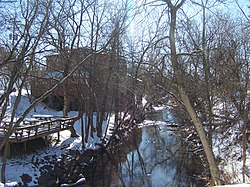Chenango Canal
|
Chenango Canal Summit Level
|
|
 |
|
| Nearest city | Norwich |
|---|---|
| Coordinates | 42°52′19″N 75°33′33″W / 42.87194°N 75.55917°WCoordinates: 42°52′19″N 75°33′33″W / 42.87194°N 75.55917°W |
| Area | 0 acres (0 ha) |
| Built | 1833 |
| MPS | Historic and Engineering Resources of the Chenango Canal MPS |
| NRHP Reference # | 05000684 |
| Added to NRHP | July 6, 2005 |
The Chenango Canal was a towpath canal built and operated in the mid-19th century in Upstate New York in the United States. It was 97 miles long and for much of its course followed the Chenango River, along Rt. 12 N-S from Binghamton on the south end to Utica on the north end. It operated from 1834 to 1878 and provided a significant link in the water transportation system of the northeastern U.S., connecting the Susquehanna River to the Erie Canal.
The canal was first proposed in the New York Legislature in 1824 during the construction of the Erie Canal, prompted by lobbying from local leaders in the Chenango Valley. It was authorized by the legislature in 1833 and completed in October 1836 at a total cost of $2,500,000- approximately twice the original appropriation. In 1833 a grand ball was held in Oxford, NY, which feted the canal's approval. The great American civil engineer John B. Jervis was appointed Chief Engineer of the project and helped in its design. This was an era of extensive canal building in the United States, following the English model, in order to provide a major transportation network for the eastern United States.
The excavation began in 1834 and was largely done by Irish and Scottish immigrant laborers, digging by hand, using pick and shovel, chipping through rock and wading through marsh. They were paid $11 per month, which was three times a common laborer's wages at the time. Skilled workers came from the completed Erie Canal project and brought new inventions, such as an ingenious stump-puller, which used oxen or mules for animal power. Work camps for the laborers were established along the route and as many as 500 men stayed in each camp. The canal opened in October, 1836, and was billed as the “best-built canal in the state”.
The Chenango Canal was 42 feet wide at the top and 26 feet wide at the bottom and averaged 4 feet deep. It had 116 locks, 11 lock houses, 12 dams, 19 aqueducts, 52 culverts, 56 road bridges, 106 farm bridges, 53 feeder bridges, and 21 waste weirs. The Chenango was unique in that it was the first reservoir-fed canal in the U.S. In this design, reservoirs were created and feeder canals were dug to bring water to the summit level of the canal. This had been done previously in Europe, but had not been tried in the US. This project had to succeed by getting almost 23 miles of waterway up an incline with a 706’ elevation, to the summit level in Bouckville, and back down a descent of 303’ to the Susquehanna river in Binghamton. At a time when there were no engineering schools in the country, and hydrology was not yet a scientific discipline, Jervis and his team were able to design a complex waterway that was considered the best of its day.
...
Wikipedia


